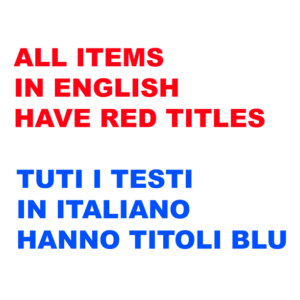
Elio
Martusciello
Concrete Songs
(Ticonzero)
Reading that a new solo album by Elio Martusciello was about to land
inside my mailbox was for me a nice surprise: though I started appreciating
Martusciello for his work with the fine quartet called Ossatura, it was
only with Unoccupied Areas (released in 2005
– checking its release date now makes me suspect that maybe I’ve missed
a few intermediate chapters, perhaps?) that I was really made aware of
his true worth.
That the title of his new album is Concrete Songs was for me quite
obvious and totally unexpected at the same time: if the word Concrete immediately
made me think of the Musique Concrète "school" that’s one of
the most important formative influences on the way Martusciello assembles
his music, to me the word Songs sounded quite strange and unusual, to say
the least, given what I remember of his past work. The CD cover has Mike
Cooper and Sabina Meyer (both needing no introduction from me, I think)
as the album’s vocalists. I had a quick look at the list of musicians featured
on the album (it’s a very long list), saw the booklet had no lyrics (which
I found quite strange, given the fact that this is supposed to be an album
of songs), and decided to listen to it immediately.
First album track, Zeit, starts with the strumming of an acoustic guitar, and
a vocal melody – by Sabina Meyer – following the chords. An orchestral
outburst of strings and sounds, vocals multiply, the whole doesn’t sound
too different from the soundtrack to a sad, grey, scenery (picture a documentary
with shepherds, goats, hills, rocks, in… Greece). Also very reminiscent
of a movie soundtrack (end credits, this time) is the track called Inexplicable:
a slow arpeggio played on classical guitar, strings (sounding with more
than a bit of a Middle-Eastern flavour), a vocal melody – by Mike Cooper
– which would be perfect when sung by the bitter nuances of, say, Charles
Aznavour. Fine melodic development, a beautiful flute solo (sounds like
it’s made of wood to me – it’s played by Anwar Naik) which reminded me
of a shakuachi.
Starting with "backwards" percussion, clarinet, a snare that sounds
just like Chris Cutler’s (yep: it’s him), electric guitar and bass sounding
quite funky, plain vocals (by Mike Cooper), Hidden Well appears to occupy
a terrain that’s mid-way between Marvin Gaye and Material, circa Memory
Serves. Black Dog surprised me even more: an arpeggio on an electric guitar,
vocals (Mike Cooper again) which reminded me of Peter Blegvad, background
vocals "Made in UK", and – the biggest surprise – an electric
guitar solo whose "square wave" timbre and linear melody reminded
me of Phil Manzanera in 1974! (It’s Martusciello – I didn’t even know he
could play guitar.)
A melody for strings and the start of the vocals on All’infinito reminded me
of Haco’s Ash In The Rainbow, but in the end the piece sounds personal
– though it features, as I learned by reading the cover,
"Variations on a theme by Fryderyk Chopin". But here I have to
confess I greatly prefer Haco’s "drier" approach, this piece sounding
a bit too "big" for my liking. Nice vocal performance by Meyer,
fine use of trombone (played by Giancarlo Schiaffini), also treated, that
– playing opposite to the strings – reminded me of the role played by Marc
Charig’s cornet on Islands by King Crimson (from the album of the same name).
The only real criticism I have when it comes to this piece is that it took
its own title a bit too literally, when half its total length (6′ 28")
could suffice.
Here I decided to stop listening for a bit, and have a look at the booklet.
I started reading the liner notes, but as soon as I found the words "Jacques
Derrida" – line three – I immediately jumped to get the braids of
garlic I keep for occasions like this (I wear them ’round my neck while
reading). Things are not that bad, really – the main exception being the
word
"photology": Martusciello talks about criteria and actual ways
of working embedded in his work. It’s apparent that this album was a great
effort for him, but it was definitely worth it. I have the feeling Martusciello
greatly feared that listeners could miss the fact that these songs had been
assembled according to criteria closely linked, entailed, by those that we
regard as being typical of Musique Concrète, and a good portion of his liner
notes is preoccupied with this and similar matters. But if "the proof
of the pudding is in the eating", I have to say that the whole here
doesn’t sound too different from, say, Strawberry Fields Forever – a song
that (even in 1967!) didn’t really need any liner notes. The same being true
for the lyrics (which in fact are not featured here).
Martusciello
warns us that "There is no hierarchical structure in these songs so
that all the ‘materials’ used (including voice and text) are put together
and treated the same". I have to confess I don’t get why this piece
of information could be of any importance for the listener (while I suspect
this could be regarded as being very important in the field of Academia,
the same being true of two or three little things that are discussed in
the liner notes). It goes without saying that this aspect pertains to the
compositional side. But when it comes to listening, it’s plain obvious
that the whole presents a hierarchy (if it’s words one fears, one could
say "a functional hierarchy, which doesn’t entail any value judgment
whatsoever"), as it’s easily demonstrated by the volume and spatial
placement of sounds (in the Western World, where "song" means "this",
but not
"that").
The
album is very well recorded and mixed. I have the impression that the album’s
"hidden complexity" was more apparent when I turned the volume
knob a bit to the right, readers beware.
Vocals by Mike Cooper, to me the instrumental part of The Elephant features
some of the album’s better moments. Dramatic-sounding orchestra, echoes,
reverbs, also treatments that doesn’t sound too far from what Eno did in
the mid-70s. Featuring classical guitar, a melody that reminded me of 70s
U.K., Mike Cooper on vocals, there’s the square wave electric guitar à
la Phil Manzanera with a pinch of Floyd, a bit of accordion (Luca Venitucci),
a cello coda (by Kees de Vrij), Swimming In Space is one of the best pieces
here. Think In An Other Light starts with an arpeggio played on electric
guitar, a vocal part (by Mike Cooper) that to me is heavily reminiscent
of John Greaves,
"fake strings", slide guitar, piano, vibraphone (Stefano Tedesco),
some minimalist-sounding bits in the background.
The giant canvas of We Have To Learn To Live In This Hybrid Space pairs an "orchestral
cha-cha-cha" to a dissonant orchestra (à la Sun Ra?); this is maybe
the album’s most layered episode. Featuring Sabina Meyer on multiple vocals,
Vanishing Point sounds like a sort of follow-up to News From Babel, the
accordion (by Aurora Dessi) reminding me a bit of Zeena Parkins, with the
accordion’s treatment (by Mr. Martusciello himself) reminding me of Biota.
Fine timbral coupling of bass clarinet (Gene Coleman) and strings. Again,
we hear a melody with a "Middle-Eastern"
flavour.
Harsh vocals (by Mike Cooper) and acoustic guitars for the album’s closing
track, That Are Raising Dingy Shades. To me it sounds a bit like a "proletarian
hymn" (in fact, it reminded me of Phil Minton).
Concrete Songs is a fine album, which in a perfect world could sell quite a
bit and give its author the chance to do many quality things for the "audience
at large". Should this happen, I hope Martusciello won’t be ashamed.
Beppe Colli
© Beppe Colli 2011
CloudsandClocks.net
| Jan. 13, 2011


